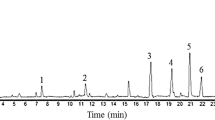Abstract
An ethanolic extract of red maple (Acer rubrum L.) leaves (RME) applied to trembling aspen (Populus tremuloides Michx.) leaves reduced feeding in choice test assays with forest tent caterpillar larvae (Malacosoma disstria Hbn.) (FTC), whereas a trembling aspen foliage extract, similarly applied, stimulated feeding. Compounds isolated from the RME were gallic acid, methyl gallate, ethyl gallate, m-digallate, ethyl m-digallate, 1-O-galloyl-β-D-glucose, 1-O-galloyl-α-L-rhamnose, kaempferol 3-O-β-D-glucoside, kaempferol 3-O-β-D-galactoside, kaempferol 3-O-β-L-rhamnoside, kaempferol-3-O-rhamnoglucoside, quercetin 3-O-β-D-glucoside, quercetin 3-O-β-L-rhamnoside and quercetin 3-O-rhamnoglucoside, (−)-epicatechin, (+)-catechin and ellagic acid. All of the gallates, (−)-epicatechin, and kaempferol 3-O-β-L-rhamnoside deterred feeding on trembling aspen leaf disks when applied at 0.28 mg/cm2. The two digallates deterred feeding by 90% and were the most effective. HPLC analysis indicated that ethyl m-digallate is present in amounts 10–100 × higher in RME (∼2.5–250 mg/g) than any other compound. Thus, ethyl m-digallate appears to be the major compound protecting red maple from feeding by FTC, with a minor contribution from other gallates.
Similar content being viewed by others
REFERENCES
ABOU-ZAID, M. M. and NOZZOLILLO, C. 1999. 1-O-Galloyl-α-L-rhamnose from Acer rubrum. Phytochemistry 52:1629–1631.
ABOU-ZAID, M. M., NOZZOLILLO, C., HELSON, B. V., and LOMBARDO, D. A. 2000a. Phenolic composition of leaves of six maple species in the Great Lakes Forest region of Canada. Polyphenol Commun. 1:95–96.
ABOU-ZAID, M. M., GRANT, G. G., HELSON, B. V., BENINGER, C. W., and DE GROOT, P. 2000b. Phenolics from deciduous leaves and coniferous needles as sources of novel control agents for lepidopteran forest pests, pp. 398–417, In Shahidi and Chi-Tang Ho (eds.). Phytochemicals and Phytopharmaceuticals. AOCS Press, Champaign, Illinois.
ADDY, N. D. 1969. Rearing the forest tent caterpillar on an artificial diet. J. Econ. Entomol. 62:270.
BAILEY, A. E., ASPLUND, R. O., and ALI, M. S. 1986. Isolation of methyl gallate as the antitumor principle of Acer saccharinum. J. Nat. Prod. 49:1149–1150.
BATE-SMITH, E. C. 1978. Systematic aspects of the astringent tannins of Acer species. Phytochemistry 17:1945–1948.
BLANEY, W. M., SIMMONDS, M. S. J., LEY, S. V., ANDERSON, J. C., SMITH, S. C., and Wood, A. 1994. Effect of azadirachtin-derived decalin (perhydronaphthalene) and dihydrofuranacetal (furo[2,3-b]pyran) fragments on the feeding behavior of Spodoptera littoralis. Pest. Sci. 40:169–173.
DELENDICK, T. J. 1990. A survey of foliar flavonoids in the Aceraceae. Mem. NY Bot. Gard. 54:1–129.
FARRAR, J. L. 1995. Trees in Canada. Canadian Forest Service & Fitzhenry and Whiteside Ltd., Markham, Ontario, Canada.
HADDOCK, E. A., GUPTA, R. K., AL-SHAFI, S. M. K., LAYDEN, K., HASLAM., E., and MAGNOLATO, D. 1982. The metabolism of gallic acid and hexahydroxydiphenic acid in plants A: Biogenetic and molecular taxonomic considerations. Phytochemistry 21:1049–1062.
HARBORNE, J. B. 1994. The Flavonoids: Advances in Research Since 1986. Chapman and Hall, London.
HASLAM, E. 1965. Galloyl esters in the Aceraceae. Phytochemistry 4:495–498.
HOWSE, G. M. 1995. Forest Insect Pests in the Ontario Region. In J. A. Armstrong and W. G. H. Ives (eds.). Forest Insect Pests in Canada. Natural Resources Canada, Ottawa, Ontario, Canada.
MARKHAM, K. R. 1982. Techniques of Flavonoid Identification, Academic Press, London.
MüLLER-SCHWARZE, D., SCHULTE, B. A., SUN, L., MüLLER-SCHWARZE, A., and MüLLER-SCHWARZE, C. 1994. Red maple (Acer rubrum) inhibits feeding by beaver (Castor canadensis). J. Chem. Ecol. 20:2021–2034.
NICOL, R. W., ARNASON, J. T., HELSON, B. V., and ABOU-ZAID, M. M. 1997. Effect of host and non-host trees on the growth and development of the forest tent caterpillar, Malacosoma disstria Hubner (Lepidoptera: Lasiocampidae). Can. Entomol. 129:995–1003.
RICKLEFS, R. E. and MATTHEWS, K. 1982. Chemical characteristics of the foliage of some deciduous trees in southeastern Ontario. Can. J. Bot. 60:2037–2045.
SINGH, P. and MOORE, R. F. 1985. Handbook of Insect Rearing, Vol II. Elsevier Science Publishers, Amsterdam, The Netherlands, 369 pp.
SLACANIN, I., MARSTON, A., HOSTETTMANN, K., DELABAYS, N., and DARABELLAY, C. 1991. Isolation and determination of flavonol glycosides from Epilobium species. J. Chromatogr. 557:391–394.
VAN SUMERE, C., FACHE, P., CASTEELE, K. V., DE COOMAN, L., EVERAERT, E., DE LOOSE, R., and HUTSEBAUT, W. 1993. Improved extraction and reversed phase high performance liquid chromatographic separation of flavonoids and identification of Rosa cultivars. Phytochem. Anal. 4:279–292.
Author information
Authors and Affiliations
Rights and permissions
About this article
Cite this article
Abou-Zaid, M.M., Helson, B.V., Nozzolillo, C. et al. Ethyl m-Digallate from Red Maple, Acer rubrum L., as the Major Resistance Factor to Forest Tent Caterpillar, Malacosoma disstria Hbn.. J Chem Ecol 27, 2517–2527 (2001). https://doi.org/10.1023/A:1013683600211
Issue Date:
DOI: https://doi.org/10.1023/A:1013683600211




